汉字的发展(英文版介绍)Chinese__character
- 格式:ppt
- 大小:6.49 MB
- 文档页数:44
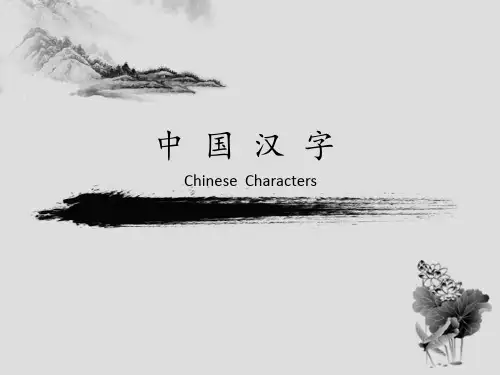
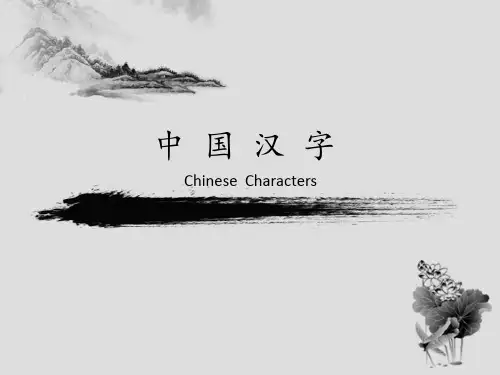
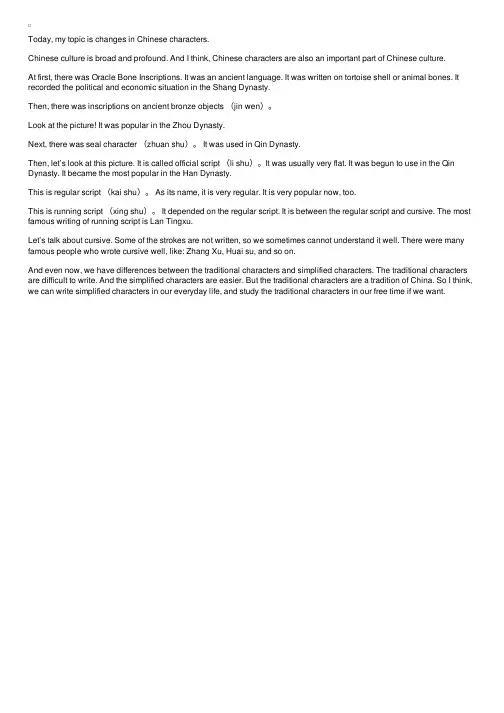
Today, my topic is changes in Chinese characters.Chinese culture is broad and profound. And I think, Chinese characters are also an important part of Chinese culture.At first, there was Oracle Bone Inscriptions. It was an ancient language. It was written on tortoise shell or animal bones. It recorded the political and economic situation in the Shang Dynasty.Then, there was inscriptions on ancient bronze objects (jin wen)。
Look at the picture! It was popular in the Zhou Dynasty.Next, there was seal character (zhuan shu)。
It was used in Qin Dynasty.Then, let’s look at this picture. It is called official script (li shu)。
It was usually very flat. It was begun to use in the Qin Dynasty. It became the most popular in the Han Dynasty.This is regular script (kai shu)。
As its name, it is very regular. It is very popular now, too.This is running script (xing shu)。
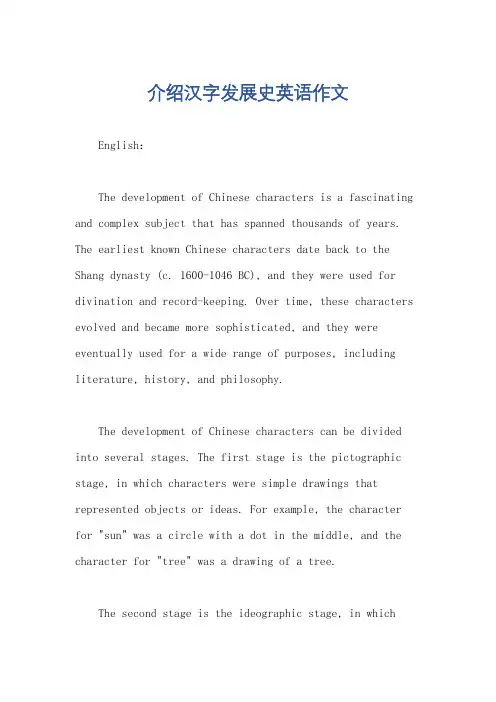
介绍汉字发展史英语作文English:The development of Chinese characters is a fascinating and complex subject that has spanned thousands of years. The earliest known Chinese characters date back to the Shang dynasty (c. 1600-1046 BC), and they were used for divination and record-keeping. Over time, these characters evolved and became more sophisticated, and they were eventually used for a wide range of purposes, including literature, history, and philosophy.The development of Chinese characters can be divided into several stages. The first stage is the pictographic stage, in which characters were simple drawings that represented objects or ideas. For example, the character for "sun" was a circle with a dot in the middle, and the character for "tree" was a drawing of a tree.The second stage is the ideographic stage, in whichcharacters began to represent more abstract concepts. For example, the character for "good" was a combination of the characters for "woman" and "child", and the character for "bad" was a combination of the characters for "woman" and "snake".The third stage is the phonetic stage, in which characters began to represent sounds. For example, the character for "ma" (horse) was originally a pictograph of a horse, but it eventually came to be used to represent the sound "ma".The fourth stage is the compound stage, in which characters were combined to form new characters. For example, the character for "Beijing" is a combination of the characters for "north" and "capital".The development of Chinese characters has been a gradual process, and it has been influenced by a variety of factors, including the development of Chinese society, the introduction of new technologies, and the influence of other cultures. Today, Chinese characters are used by over1 billion people around the world, and they are an essential part of Chinese culture.Chinese:汉字的发展历史是一门迷人而复杂的研究课题,其历史已绵延数千年。
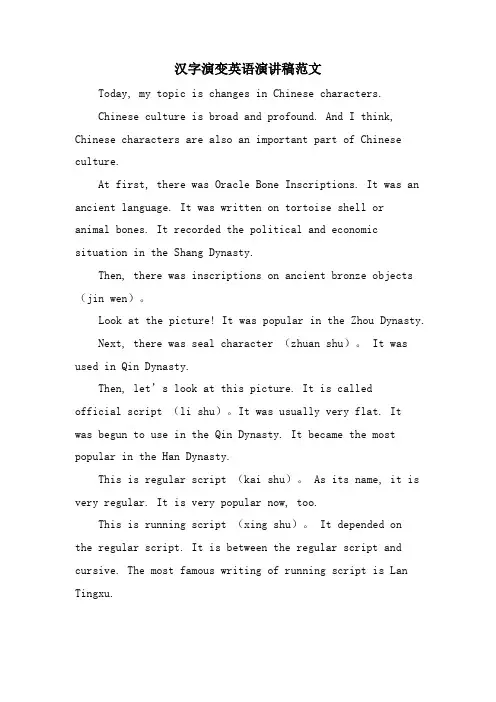
汉字演变英语演讲稿范文Today, my topic is changes in Chinese characters.Chinese culture is broad and profound. And I think, Chinese characters are also an important part of Chinese culture.At first, there was Oracle Bone Inscriptions. It was an ancient language. It was written on tortoise shell oranimal bones. It recorded the political and economic situation in the Shang Dynasty.Then, there was inscriptions on ancient bronze objects (jin wen)。
Look at the picture! It was popular in the Zhou Dynasty.Next, there was seal character (zhuan shu)。
It was used in Qin Dynasty.Then, let’s look at this picture. It is calledofficial script (li shu)。
It was usually very flat. Itwas begun to use in the Qin Dynasty. It became the most popular in the Han Dynasty.This is regular script (kai shu)。
As its name, it is very regular. It is very popular now, too.This is running script (xing shu)。

汉字的发展有关的英语作文The evolution of Chinese characters is a mesmerizing journey through time, a tapestry woven with intricate strokes and profound meanings. From the ancient oracle bones to the digital era, these characters have endured, morphing and adapting with the tides of history.In the beginning, characters were born from the strokes of brush and ink, crafted by sages and scholars seeking to capture the essence of the world around them. Each stroke carried with it layers of symbolism and tradition, a reflection of the culture that birthed it.As time marched on, the characters evolved, branching out into myriad styles and forms. Calligraphy became an art form in its own right, with masters wielding their brushes like swords, leaving behind trails of ink that danced across the page.With the advent of printing, characters took on newlife, reproduced en masse and disseminated across vast swathes of land. The written word became accessible to the masses, empowering the common people with knowledge and wisdom.But it was in the digital age that characters truly came into their own. No longer confined to paper and ink, they leaped onto screens and keyboards, transcendingphysical boundaries and connecting people across continents.Today, Chinese characters continue to evolve, shaped by the forces of globalization and technology. Emoticons and emojis add new layers of meaning, infusing the written word with a touch of whimsy and playfulness.Yet, amidst all this change, the essence of the characters remains unchanged. They are more than just symbols on a page; they are the threads that bind together the fabric of Chinese culture, weaving a story that spans thousands of years.。
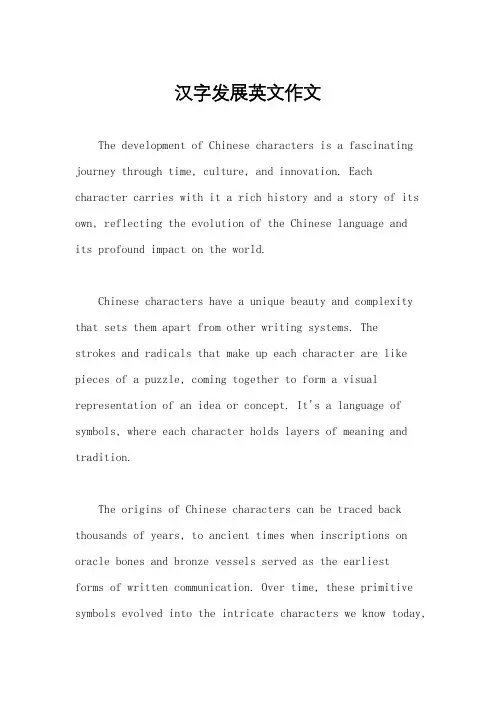
汉字发展英文作文The development of Chinese characters is a fascinating journey through time, culture, and innovation. Each character carries with it a rich history and a story of its own, reflecting the evolution of the Chinese language andits profound impact on the world.Chinese characters have a unique beauty and complexity that sets them apart from other writing systems. Thestrokes and radicals that make up each character are like pieces of a puzzle, coming together to form a visual representation of an idea or concept. It's a language of symbols, where each character holds layers of meaning and tradition.The origins of Chinese characters can be traced back thousands of years, to ancient times when inscriptions on oracle bones and bronze vessels served as the earliestforms of written communication. Over time, these primitive symbols evolved into the intricate characters we know today,shaped by the influence of different dynasties, cultural exchanges, and technological advancements.The spread of Chinese characters beyond China's borders has had a profound impact on global communication and understanding. As Chinese culture and language have spread around the world, so too have its characters, finding their way into the written systems of other languages and leaving an indelible mark on global culture.The ongoing digital revolution has brought new challenges and opportunities for the development of Chinese characters. With the rise of technology, there is a constant tension between preserving the traditional art of calligraphy and adapting characters to fit the constraints of digital devices. However, this tension has also sparked creativity, leading to new forms of expression and designin the realm of Chinese typography.In conclusion, the development of Chinese characters is a testament to the enduring power of language and culture. From their ancient origins to their modern-day adaptations,Chinese characters continue to captivate and inspire, serving as a bridge between the past and the future.。
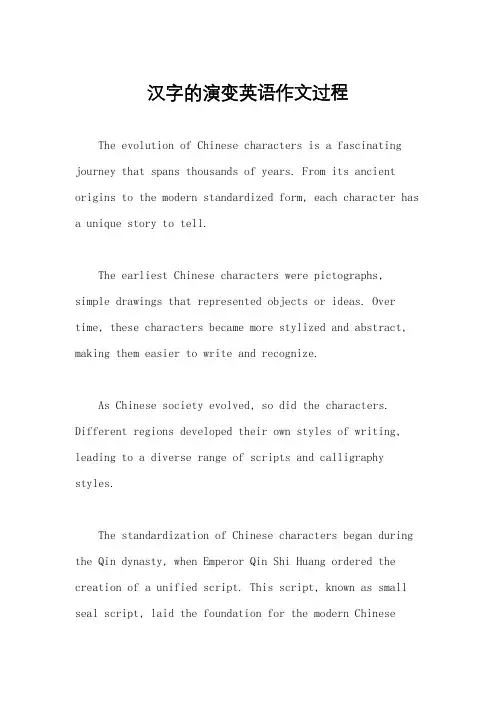
汉字的演变英语作文过程The evolution of Chinese characters is a fascinating journey that spans thousands of years. From its ancient origins to the modern standardized form, each character has a unique story to tell.The earliest Chinese characters were pictographs, simple drawings that represented objects or ideas. Over time, these characters became more stylized and abstract, making them easier to write and recognize.As Chinese society evolved, so did the characters. Different regions developed their own styles of writing, leading to a diverse range of scripts and calligraphy styles.The standardization of Chinese characters began during the Qin dynasty, when Emperor Qin Shi Huang ordered the creation of a unified script. This script, known as small seal script, laid the foundation for the modern Chinesewriting system.The development of printing technology in ancient China played a crucial role in the spread and preservation of Chinese characters. Woodblock printing allowed for the mass production of texts, making literacy more accessible to the general population.In the modern era, the Chinese writing system has undergone further reforms to simplify characters and promote literacy. The introduction of simplified characters in mainland China has made it easier for people to learn and use Chinese in their daily lives.Despite these changes, the beauty and complexity of Chinese characters remain a source of fascination for people around the world. Each character is like a work of art, with its own history and meaning waiting to be discovered.。
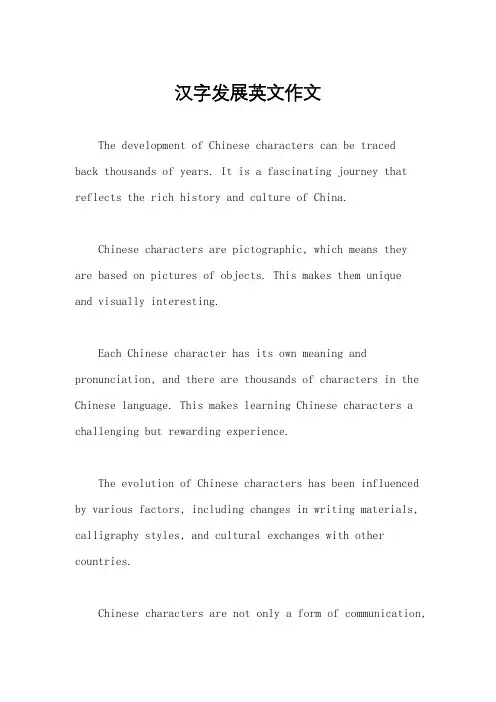
汉字发展英文作文The development of Chinese characters can be tracedback thousands of years. It is a fascinating journey that reflects the rich history and culture of China.Chinese characters are pictographic, which means they are based on pictures of objects. This makes them uniqueand visually interesting.Each Chinese character has its own meaning and pronunciation, and there are thousands of characters in the Chinese language. This makes learning Chinese characters a challenging but rewarding experience.The evolution of Chinese characters has been influenced by various factors, including changes in writing materials, calligraphy styles, and cultural exchanges with other countries.Chinese characters are not only a form of communication,but also a form of art. The beauty of Chinese calligraphy lies in the graceful strokes and the balance of the characters.In today's digital age, the use of Chinese characters has expanded beyond traditional writing. They are now used in digital communication, advertising, and design, showcasing the adaptability and versatility of the characters.The preservation and promotion of Chinese characters are important for the continuation of Chinese culture and heritage. Efforts are being made to ensure that future generations will continue to appreciate and understand the beauty and significance of Chinese characters.。

汉字的发展史英语作文500字The Evolution of Chinese Characters: A Historical Journey.Chinese characters, the foundation of the Chinese language, have undergone a remarkable transformation throughout history. Their development, spanning millennia, is a testament to the ingenuity and creativity of the Chinese people.Early Origins and Pictograms.The earliest known Chinese characters emerged around 1200 BCE during the Shang dynasty. These were pictographs, rudimentary symbols that directly represented objects or concepts. For instance, the character "日" (ri), meaning "sun," resembled the shape of the celestial body.Oracle Bone Inscriptions and Bronzeware Scripts.During the Zhou dynasty (1046-256 BCE), Chinese characters were inscribed on oracle bones and bronzeware vessels. These inscriptions served various purposes, from divination to record-keeping. The characters became more sophisticated, incorporating stylizations and abstract elements.The Standardization of the Han Dynasty.The Han dynasty (206 BCE-220 CE) marked a significant milestone in the development of Chinese characters. Emperor Qin Shi Huang unified the script, standardizing the written language across the empire. The resulting script, known as "lishu" (clerical script), became the basis for subsequent character forms.Evolution of Calligraphy.As the Han dynasty progressed, calligraphy emerged as a refined art form. Master calligraphers developed various styles, including "kaishu" (regular script), "xingshu" (running script), and "caoshu" (grass script). These stylesenhanced the aesthetic appeal of Chinese characters, making them both visually pleasing and expressive.The Influence of Buddhism.The introduction of Buddhism into China during the Northern and Southern dynasties (420-589 CE) had a profound impact on character development. Buddhist texts brought with them new concepts and technical terms, necessitating the creation of new characters.The Rise of Printing.The invention of printing during the Song dynasty (960-1279 CE) revolutionized the dissemination of knowledge and the spread of Chinese characters. Woodblock printing allowed for the mass production of books, making written materials more widely accessible.Simplification in the 20th Century.In the 20th century, the Chinese government undertook amajor reform of the Chinese character system. Complex traditional characters were simplified to make them easier to learn and write. This simplification, known as the "Simplified Character System," became the standard scriptin mainland China.Contemporary Evolution.In the digital age, Chinese characters continue to evolve. With the advent of computers and smartphones, electronic devices have introduced new ways of inputting and displaying characters. Additionally, the rise of social media has facilitated the creation and spread of new slang terms and informal character usage.Conclusion.The history of Chinese characters is a testament to the resilience and adaptability of the Chinese language. From humble beginnings as pictographs to the sophisticated characters used today, Chinese writing has undergone a remarkable journey that reflects the cultural andtechnological advancements of Chinese civilization. As the language continues to evolve, Chinese characters will undoubtedly remain a vital and dynamic element of Chinese expression.。
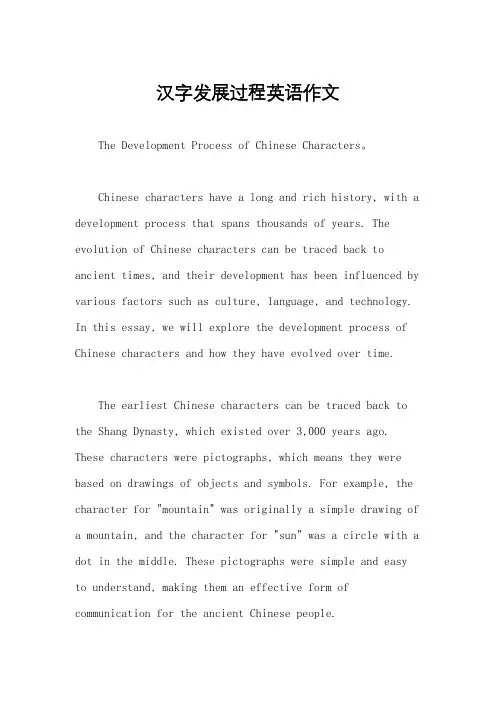
汉字发展过程英语作文The Development Process of Chinese Characters。
Chinese characters have a long and rich history, with a development process that spans thousands of years. The evolution of Chinese characters can be traced back to ancient times, and their development has been influenced by various factors such as culture, language, and technology. In this essay, we will explore the development process of Chinese characters and how they have evolved over time.The earliest Chinese characters can be traced back to the Shang Dynasty, which existed over 3,000 years ago. These characters were pictographs, which means they were based on drawings of objects and symbols. For example, the character for "mountain" was originally a simple drawing of a mountain, and the character for "sun" was a circle with a dot in the middle. These pictographs were simple and easy to understand, making them an effective form of communication for the ancient Chinese people.As time passed, the Chinese characters evolved from pictographs to ideographs. Ideographs are characters that represent ideas or concepts rather than physical objects. This shift in the structure of Chinese characters allowed for a more abstract and nuanced form of communication. For example, the character for "love" is a combination of the characters for "heart" and "friend," symbolizing the concept of affection and friendship.During the Qin and Han Dynasties, the Chinese characters underwent another significant change with the standardization of the script. This standardization was led by the first emperor of China, Qin Shi Huang, who sought to unify the writing system in order to facilitate communication and governance. The result was the creation of the small seal script, which became the standard form of writing for centuries to come.In the following dynasties, the Chinese characters continued to evolve, with the introduction of new styles of calligraphy and the development of printing technology. Thecalligraphy of the Tang Dynasty, for example, is renowned for its elegance and grace, and it had a profound influence on the development of Chinese characters. Additionally, the invention of woodblock printing during the Song Dynasty allowed for the mass production of books, which further spread the use of Chinese characters throughout China and beyond.In modern times, the Chinese characters have continued to evolve with the advent of technology. The development of computers and smartphones has led to the creation of simplified and traditional Chinese characters, as well as the adoption of Pinyin, a system for transcribing Chinese characters into the Latin alphabet. These advancements have made it easier for people to learn and use Chinese characters, and they have also facilitated the global spread of the Chinese language.In conclusion, the development process of Chinese characters is a testament to the rich history and culture of China. From their origins as pictographs to their modern-day use in technology, Chinese characters haveevolved in response to the changing needs of society. As a result, they continue to be an integral part of Chinese culture and a unique and fascinating form of writing.。
中国汉字演变英文作文高中The Evolution of Chinese Characters into English。
Chinese characters have a long and rich history that dates back thousands of years. As one of the oldest writing systems in the world, they have evolved over time and have been used to write various languages, including Mandarin, Cantonese, and Japanese. In recent years, Chinesecharacters have also made their way into the English language, creating a unique blend of cultures and languages.The earliest Chinese characters were pictographs, which were simple drawings that represented objects or ideas. For example, the character for "sun" was a circle with a dot in the center, while the character for "moon" was a crescent shape. Over time, these pictographs became more abstract, and new characters were created by combining existing ones.During the Qin Dynasty (221-206 BCE), the first standardized Chinese script was created, known as sealscript. This script was used for official documents and inscriptions on bronze vessels. It was later replaced by clerical script, which was easier to write and became the standard script for everyday use.As Chinese characters spread throughout East Asia, they were adapted to fit the languages and cultures of different regions. In Japan, for example, Chinese characters were combined with native Japanese scripts to create a writing system known as kanji. Similarly, in Korea, Chinese characters were used alongside the native Korean script, known as hangul.In recent years, Chinese characters have also madetheir way into the English language. This is largely due to the popularity of Chinese culture and the increasing number of Chinese speakers around the world. Many English wordsare now written using Chinese characters, such as "qi" (气), which is used to represent the concept of energy or life force, and "feng shui" (风水), which refers to the Chinese practice of arranging objects and spaces to promote harmony and balance.In addition, many English words are now beingtranslated into Chinese characters, creating a unique blend of cultures and languages. For example, the word "internet" is now commonly written as "互联网" in Chinese characters, while the word "hamburger" is written as "汉堡包".Overall, the evolution of Chinese characters into English is a testament to the power of language and culture to transcend borders and bring people together. As the world becomes increasingly interconnected, we can expect to see more and more examples of this unique blend of cultures and languages in the years to come.。
英语(汉字的发展)英语(汉字的发展)The Development of Chinese CharactersChinese characters are logograms used in the writing of Chinese and some other Asian languages. Chinese characters constitute the oldest continuously used system of writing in the world. Chinese characters are among the most widely adopted writing systems in the world by number of users.Legendary originsAccording to legend, Chinese characters were invented by Cangjie, a bureaucrat under the legendary Yellow Emperor. Inspired by his study of the animals of the world, the landscape of the earth and the stars in the sky, Cangjie is said to have invented symbols called zì–the first Chinese characters. The legend relates that on the day the characters were created, people heard ghosts wailing and saw crops falling like rain.Early sign useMain article: Neolithic signs in ChinaIn recent decades, a series of inscribed graphs and pictures have been foundat Neolithic sites in China, including Jiahu (c. 6500 BC), Dadiwan and Damaidi from the 6th millennium BC, and Banpo (5th millennium BC). Often these finds are accompanied by media reports that push back the purported beginnings of Chinese writing by thousands of years. However, because these marks occur singly, without any implied context, and are made crudely and simply, Qiu Xiguiconcluded that "we do not have any basis for stating that these constituted writing nor is there reason to conclude that they were ancestral to Chinese characters." Theydo however demonstrate a history of sign use in the Yellow River valley during the Neolithic through to the Shang period.Oracle bone scriptThe earliest confirmed evidence of the Chinese script yet discovered is the body of inscriptions carved on oracle bones from the late Shang dynasty (c. 1200–1050 BC). In 1899, pieces of these bones were being sold as "dragon bones" for medicinal。
汉字演变英语演讲稿范⽂ Today, my topic is changes in Chinese characters. Chinese culture is broad and profound. And I think, Chinese characters are also an important part of Chinese culture. At first, there was Oracle Bone Inscriptions. It was an ancient language. It was written on tortoise shell or animal bones. It recorded the political and economic situation in the Shang Dynasty. Then, there was inscriptions on ancient bronze objects (jin wen)。
Look at the picture! It was popular in the Zhou Dynasty. Next, there was seal character (zhuan shu)。
It was used in Qin Dynasty. Then, let’s look at this picture. It is called official script (li shu)。
It was usually very flat. It was begun to use in the Qin Dynasty. It became the most popular in the Han Dynasty. This is regular script (kai shu)。
As its name, it is very regular. It is very popular now, too. This is running script (xing shu)。
写汉语的发展的英文作文The development of Chinese language can be traced back thousands of years, evolving from ancient pictographs to the complex characters we see today.Chinese characters are not only a form of writing, but also a reflection of the culture and history of China. Each character carries its own meaning and pronunciation, making Chinese a unique and fascinating language.In recent years, the popularity of Mandarin Chinese has been on the rise, with more and more people around the world learning the language for business, travel, and cultural exchange.The rise of technology has also had a significant impact on the development of Chinese language, with the invention of pinyin input method making it easier for people to type Chinese characters on computers and smartphones.Despite the challenges of learning Chinese characters, many people are drawn to the beauty and complexity of the language, finding joy in mastering its intricacies and nuances.As China continues to play a prominent role on the global stage, the importance of Chinese language proficiency is only expected to grow, making it a valuable skill for anyone looking to succeed in the 21st century.。